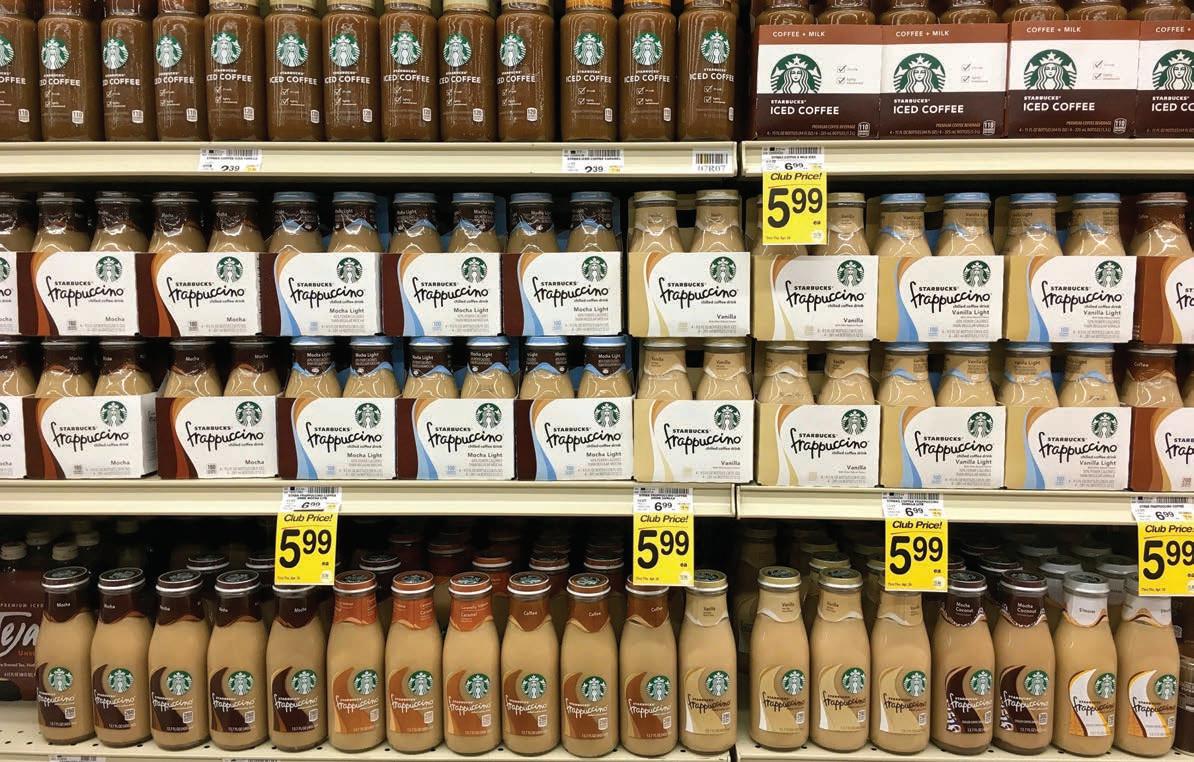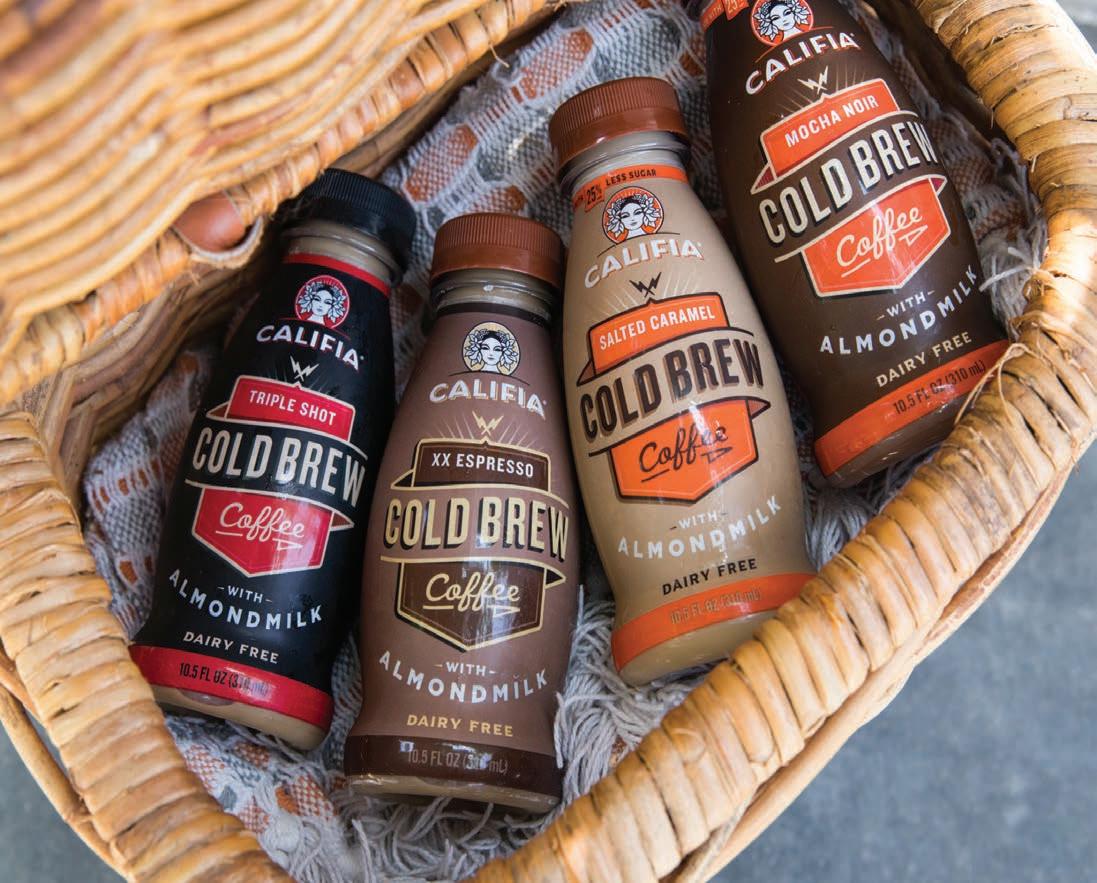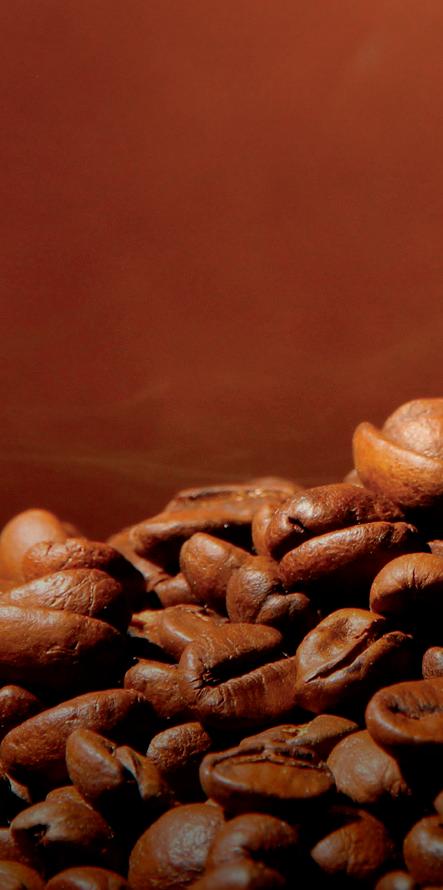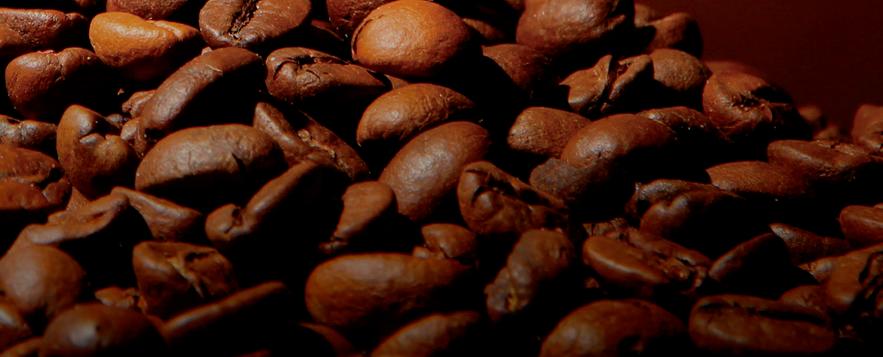
13 minute read
RTD ON THE RISE
from GCR May 2020
by Prime Group
GLOBAL COFFEE REPORT LOOKS AT THE BOOM OF THE READY-TODRINK COFFEE MARKET, LED BY A GROWING COFFEE CULTURE, HEALTH CONSCIOUS CONSUMERS, AND WIDE FUNCTIONALITY.
Carbonated soft drinks have experienced a huge decline in popularity over the last few years as consumers become warier of sugar and artificial flavouring.
According to Euromonitor Senior Beverage Analyst Matthew Barry, this has created opportunities for other beverages to fill the void, with bottled water the beverage category that benefits most from the decline of carbonates. Barry tells Global Coffee Report that ready-to-drink (RTD) coffee is another increasingly attractive option.
“We’re seeing a lot of occasions opening up where, if someone isn’t drinking a carbonated soft drink, what are they drinking instead?” Barry asks.
“If you were drinking a soft drink for the caffeine or energy, you need to substitute it with something else. RTD coffee is succeeding in places where it can poach those occasions successfully.”
Declining popularity of carbonates is only one of many reasons that the RTD coffee market has seen a spike in popularity. Barry says the rise of café culture in many countries is the main driver of coffee in the RTD space, as it leads to a greater knowledge and appreciation of coffee and the ways it can be consumed.
“As coffee shop culture expands worldwide, RTD coffee follows in its wake, particularly as cold coffee becomes popular,” he says.
“There are also plenty of places with strong café cultures where RTD coffee isn’t taking off as well, like Italy. That’s probably because these countries don’t particularly value cold coffee. Places that do praise cold coffee, the United Kingdom for example, have a more correspondingly active RTD market.” CALIFIA CALLING One of the RTD coffee brands to quickly gain momentum across the world is the USbased Califia Farms. The plant-based beverage company received US$225 million in a financing round in January 2020 to build on the success of its oat platform and launch other product lines.
Califia Farms produces plant-based milks in a variety of formats for the coffee industry, including barista milks and creamers. CEO and Founder Greg Steltenpohl tells GCR the company’s interest in RTD coffee came from
developing its milks profiles to be compatible with coffee.
“We started making dairy alternatives and found some combinations of coffee with almond or oat milks tasted better than with dairy, due to certain flavour notes and personality,” Steltenpohl says.
“Looking at the macro profile, plant milks are lower in fat and sugar, so it can provide more transparency with lighter cold brews than dairy. If you’ve got a well roasted product, it allows the coffee to stand on its own terms.”
In the last few years, Califia Farms has built a strong following, particularly in the natural foods segment, where it leads the RTD coffee market.
Other than health, Steltenpohl says a key component of Califia Farms’ popularity is its commitment to sustainability, particularly in the sourcing of its coffee.
Califia Farms supports the direct trade model, paying a premium for its coffee, verifying the farm gate price paid to farmers, and maintaining transparency and traceability with cooperatives and importers.
“We focus on a small group of grower and cooperative suppliers and buy over a multi-year period so they have a reliable level of economic support,” Steltenpohl says.
“First and foremost, people want the taste, variety, and functionality, but after that, brand loyalty is determined by the ethics of the company.”
Alongside the US, Califia Farms’ major markets include Canada, the UK, Australia, Hong Kong, Singapore, and Mexico. Steltenpohl says the UK is its strongest RTD market, due to the government’s heavy messaging on health and reducing sugar intake.
With Califia Farms established in Western countries, Califia Farms focus for expansion is Asia and the Middle East.
“The Middle East has high temperatures, a strong coffee culture, and plenty of occasions where people are out and about and looking for mobility,” Steltenpohl says.
“Plant milks aren’t really established yet in Asia, so we see potential in a market already familiar with RTD coffee, especially Japan.”
THE FANTASTIC FOUR Although the global RTD market has become more complex in recent years, Euromonitor’s Barry says historically, it could be broken down into four categories.
Japan was the first country to see the potential in the RTD market for coffee. Barry says its popularity blossomed in the 1970s, when companies like Suntory and Ueshima Coffee Company began selling coffee in cans throughout the country’s major cities.
Today, Japan is notorious for the coffee vending machines sitting on every street corner. Barry says the RTD market in Japan has always emphasised functionality, and is still the largest in the world.
high quality Coffee that TasTes like fresh brewed instant Create


the integrated extraCtion system Naturally Premium Coffee
Califia Farms entered the RTD coffee market after finding profiles that complemented its plant-based milks.

“These products were designed to get people through the country’s notoriously long working days,” he says. “Now, the Japanese worker can get it from a vending machine most places any time of the day.”
While this is where the RTD coffee market started, Barry says this focus on functionality was isolated to Japan and surrounding Asian countries. Other markets emerged independently with their own preferences.
In Europe, particularly German speaking countries, dairy producers like the Emmi Group dominated the RTD coffee market until recently. Many of these products were mixed with milk and sugar, unlike the predominately black Japanese market, to appeal to local tastes.
“If you look at what was selling in Europe a decade ago, it was almost exclusively these types of drinks,” Barry says.
“Even on the shelves, you’d find RTD coffee next to the milk products, which isn’t necessarily the case in the US or Japan.”
Similarly to Europe, the Australian market features RTD and iced coffee drinks filled with milk and sugar. Barry says the key difference between the two markets is Australia’s focus on multi-serve products.
“You see RTD coffee in bigger pack sizes, with companies like Farmers Union quite popular in Australia. It’s a lot more unusual worldwide,” he says.
“In the long term, this Australian style could face challenges. It’s sweeter, milkier, and runs into the same sugar concerns dogging the carbonates category.”
With globalisation bringing divergent coffee cultures together, the fourth market style – North America – is the one Barry believes has gained the most traction.
In this market, RTD coffee has been heavily tied to coffee shops and chains, leveraging off the brand recognition to build a foothold.
“The American market can probably be traced back to the 1990s, when Starbucks started distributing its Fall Frappuccino line with Pepsi Co. They probably thought: ‘people like our frappucinnos in food service, what if we sold them in a retail setting?’,” Barry says.
“This American type of coffee is still doing well in the US and Canada and has expanded internationally. Of the four, it’s very clear the American type is winning out and I think it’s because of how it has attached itself to the coffee shop.”
PLAYING WITH THE BIG BOYS Total beverage companies have also taken notice of how brands hold value in the RTD coffee market. Coca-Cola completed its acquisition of British chain Costa Coffee in early 2019 and launched a range of RTD coffee drinks under the brand in the UK later that year. Barry says Coca-Cola also produces RTD coffee in the US under licenses from Dunkin’ and McCafé among other brands.
“There’s a shift in wider beverage companies towards the coffee space. As their core markets struggle, they see this as a growth area, where young people are drinking and there is a lot of potential,” Barry says.
“When you think about Coca-Cola, you picture that iconic red can. They don’t just want to sell more of that. They want to be drunk in different occasions. If you want to be a total beverage company, like Coca-Cola and its competitors do, you need a viable a coffee strategy.”
He says RTD is the most appealing avenue into coffee due to their existing strengths in distribution, bottling, and marketing.
However, total beverage companies have also begun using their own names in relation to coffee. Coca-Cola and Pepsi Co have both released variants of their signature drinks combined with coffee. Barry says these drinks market themselves mainly on caffeine content, and try to fill the niche between soft drinks and energy drinks.
FORM FOLLOWS FUNCTION The line between coffee and energy drinks has become increasingly blurred as products like High Brew Coffee, Java and Caffé Monster, and Starbucks Doubleshot Energy Coffee complicate the market.
“Energy drinks are still doing well, but the two categories are getting close together. It’s tricky because in some cases, energy drinks are becoming more like coffee and vice versa,” Barry says.
“This is part of an emerging functional category. We’re seeing a lot of coffee drinks competing for the same occasions as energy drinks while others are targeting completely different markets.”
While café culture and brand identity have led the growth of RTD coffee, Barry says
moving forward, functionality is influencing many new products in the market.
“It’s still a pretty small market in terms of sales, but functionality dominates in product launches. We’ve started to see many brands appear, for example, with CBD – or cannabis – coffee, which could offer an energy boot in a less jittery way,” Barry says. “We don’t know for sure if that’s the case yet because it’s still very new.”
RTD coffee’s functionality extends beyond offering an energy boost. Coffee can be customised in many ways to create new products that fill different niches in the market. Nitro, sparkling, and alcoholic coffee are trends from food service that have leaked into the retail space, which Barry says has kept RTD coffee “exciting” and its growth rate high.
This is only the tip of the iceberg when it comes to RTD coffee’s versatility.
“Cold brew is naturally healthy with low sugar and artificial content, so it’s a good base for other products,” Barry says.
“The question is: ‘what can we do with it?’ And we’re starting to see answers.”

MILLENNIALS ARE THE FUTURE Many of the trends and factors driving the RTD coffee market are most appealing to or caused by the millennial generation.
“It goes back to coffee shop culture. It’s younger people who are spending more time in coffee shops and prefer cold coffee,” Barry says.
“Particularly in the US, there’s a stronger preference among younger people than previous generations for cold brew, which benefits RTD which is almost always served cold. Then there’s their presence in the on-the-go segment that RTD is also targeting.”
As the main consumers of plant milks, millennials are also likely contributing to the success of dairy alternatives in the RTD coffee market. As well as Califia Farms, Sweden’s Oatly, England’s Minor Figures, and numerous coffee roasters have made plays in the space.
Califia Farms’ Steltenpohl says millennials are making more health, quality, and money conscious decisions than their parents and grandparents.
“Americans typically have a very sweet taste palate, but many younger people were raised on low sugar diets. They’re also willing to seek out those specialty taste profiles that craft coffee has made popular,” he says. This is also translating to the popularity of Califia Farms’ larger bottles in grocery and natural food stores.
“People are finding good value cost-per-ounce by buying a multiserve container. For the price of one large latte at a specialty store, they can have six servings at home. It’s quite a pragmatic solution for many younger consumers.”
With growing interest in on-the-go functionality, coffee shop culture well ingrained, and healthy alternatives on the rise, Euromonitor’s Barry says the RTD coffee market has a bright future.
“RTD coffee can be an indulgent sugary beverage that’s just a treat if it wants. It can also be purely functional, very much like an energy drink, and everything in between,” Barry says.
“You can do a lot with RTD coffee and I don’t think the market is even close to figuring out all of the possibilities.” GCR
MAY/JUNE 2020




www.gcrmag.com
COFFEE FINDS A HOME COLLATERAL DAMAGE CLOSING THE GAP IN THE EYE OF THE STORM SOLUTIONS DIRECTOR OF BUENCAFÉ CONSTANZA MEJÍA ON HELPING INCREASE THE ECONOMIC SECURITY OF MORE THAN 540,000 COLOMBIAN FARMERS www.gcrmag.com MARCH/APRIL 2020 GRUPPO GIMOKA BOARD MEMBER MARCO PADELLI ON HOW THE ITALIAN ROASTER EXECUTES ITS SUSTAINABLE RESPONSIBILITIES IN A COMPETITIVE LANDSCAPE CONTROL COMPLETE THE NEXT BATTLE Former Colombian combatants trade in rifles and fatigues to cultivate coffee THIRD TIME’S A CHARM Domestic consumption and specialty market help reverse Cameroon’s production decline BLOCKCHAIN REACTION Tracing coffees and raising awareness
LESS IS MORE New research challenges the most efficient way to brew espresso coffee
China’s booming industry and the big names competing for marketshare
Nicaragua’s politicial crisis takes its toll New ICO research shows variation in production costs and farm profi tability IN THE EYE OF THE STORM
EXECUTES ITS SUSTAINABLE RESPONSIBILITIES IN A COMPETITIVE LANDSCAPE www.gcrmag.com LÖFBERGS GROUP CEO LARS APPELQVIST ON LEADING ONE OF THE NORDIC REGION’S LARGEST FAMILY-OWNED ROASTING BUSINESSES AND MAKING BOLD DECISIONS IN HARD TIMES.
DREAM DARE TO RTD ON THE RISE A booming market driven by millennials THE MOTHER OF ALL CAUSES Will 2020 be the tipping point of climate change for the global coffee industry? STARS ALIGN FOR ETHIOPIA The inaugural COE competition and open export market create new opportunities A NEW KIND OF THREAT How will the market react to the spread of COVID-19 and a decline in commercial activity? Global Coffee Report is the leading business magazine covering the
ECONOMIC SECURITY OF MORE THAN 540,000 COLOMBIAN FARMERS FAMILY-OWNED ROASTING BUSINESSES AND MAKING BOLD DECISIONS IN HARD TIMES. UNLIMITED ONLINE CONTENT




















international coffee industry. In-depth international coffee industry. In-depth features explore on-the-ground developments at origin, coffee pricing developments at origin, coffee pricing



issues, technology updates, research breakthroughs and much more. issues, technology updates, research













